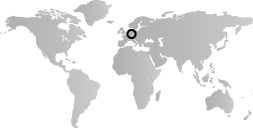In the first half of the twentieth century, Germany and Switzerland are profoundly affected by world wars, although Switzerland maintains its neutrality throughout. After World War I, the severe penalties placed on Germany by the Allies create harsh economic conditions that fuel the rise to power of Adolf Hitler (1889–1945), who will lead Germany into fascism and World War II in 1939. Hitler also heads a regime that orchestrates the Holocaust, a horrific legacy with which subsequent generations struggle to come to terms. The period immediately following World War II is occupied with rebuilding the devastated country, which is now split into two separate entities, the Federal Republic of Germany (West Germany) and the German Democratic Republic (East Germany), the latter a member of the Warsaw Pact allied with the Soviet Union.
The postwar period in Germany is colored by the Cold War between communist and democratic states, with which East and West Germany are respectively aligned. Germany is reunified with the collapse of the Soviet Union at the end of the twentieth century. The reunification brings together countries with two vastly different economies, the industrialized and prosperous West Germany and the comparatively impoverished East Germany. By the mid-1990s, the rise of support for far-right political parties in Switzerland and Germany is accompanied by an escalation of violence against immigrants and opposition to membership in the European Union.
Throughout the century, Germany and Switzerland are at the forefront of all fields of the arts. In Germany, artists engage new conceptions of the inner self formulated by Sigmund Freud; at the same time, they respond to industrialization with programs for reforming the design and production of architecture and furnishings. The rise of fascism politicizes artmaking as the Nazi regime equates modernism with degeneracy and drives many avant-garde artists out of the country. After the war, many German artists—East and West—produce works that reflect their personal experiences of its attendant horrors. Cultural production in East Germany is subject to the political climate, fluctuating between periods of vigilant ideological scrutiny and liberal thaws. Reunification of the nation, and particularly of the city of Berlin, occasions an enormous building campaign by internationally recognized architects, producing important postmodern monuments.


